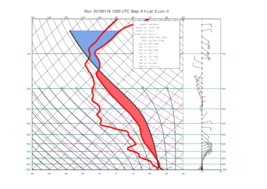| Section |
|---|
| Column |
|---|
| What is GRIB?GRIB is the WMO's format for binary gridded data. The Metview GRIB interface is based on ecCodes and can handle both GRIB edition 1 and edition 2 seamlessly. |
|
...
The GRIB iconGRIB files are represented by this icon in the user interface:  Image Added Image Added
|
|
...
Examining GRIB contentsThe contents of a GRIB file can be inspected with the GRIB Examiner, which can be |
|
...
| Info |
|---|
|
metview -e grib your_grib
|
started up from the user interface (right-click examine on the icon) |
|
...
.  Image Added Image Added
|
|
Visualisation on mapsGRIB fields (with the exception of spherical harmonics fields) can be directly visualised in Metview on a map view. In the user interface just right-click visualise on the icon to get a plot with the default settings. GRIB map plots can be further customised with the Contouring or Wind Plotting icons for scalar fields or vector fields, respectively. |
|
...
Visualisation on other views |
|
...
...
...
...
prepare thermodynamic profiles which then can |
|
...
be visualised in a tephigram, |
|
...
...
...
 Image Added Image Added
Filtering and interpolationThe GRIB Filter icon provides the means to select a subset of fields from a GRIB file. It (and the MARS Retrieval icon) also contains some parameters, such as Grid and Area, which allow for interpolation to a new grid. Data processingThere are quite a few icons available in Metview to process GRIB data. These include the icons mentioned above and the following other icons: Metview's script interface provides access to all these icons and also offers a rich set of functions and operators to work with GRIB data (see Script language support below). Retrieval from MARSIf |
|
...
Metview has been configured with access to ECMWF's MARS archive, GRIB data can be retrieved via the Mars Retrieval icon. At ECMWF, MARS access is set up on all computer systems, while outside ECMWF the MARS Web API could be used in Metview (see the setup instructions here). Script language supportMetview provides full support for GRIB from its Macro and Python interfaces. In script, GRIB data is represented as a fieldset. Fieldset handling is probably Metview's richest and most powerful interface including (on top of the icon functions): - high-level field arithmetic
- filtering and interpolation
- masking, bitmaps
- GRIB header and value access and modification
- statistics, horizontal aggregations and vertical computations
- derivatives
- and many more ...
The full list of available functions and operators on fieldsets can be found on the Fieldset Functions |
|
...
Tutorials
The main tutorial about using ODB in Metview can be found here. There is also a shorter tutorial available on this page.
Gallery
The Gallery features a few ODB-related examples showcasing both the ODB Filter and ODB Visualiser icons.
lation) have access to a MARS archive, Metview can retrieve GRIB data via the Mars Retrieval icon. Once the data has been retrieved, the icon text will turn green to indicate that it has been cached; operations such as Visualise and Examine will work on the cached data. If any of the parameters in the Mars Retrieval icon are changed, or if Metview is restarted then the cached data will be removed.
...






